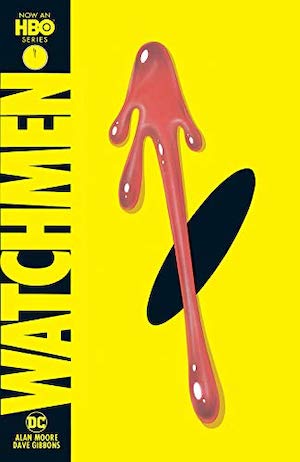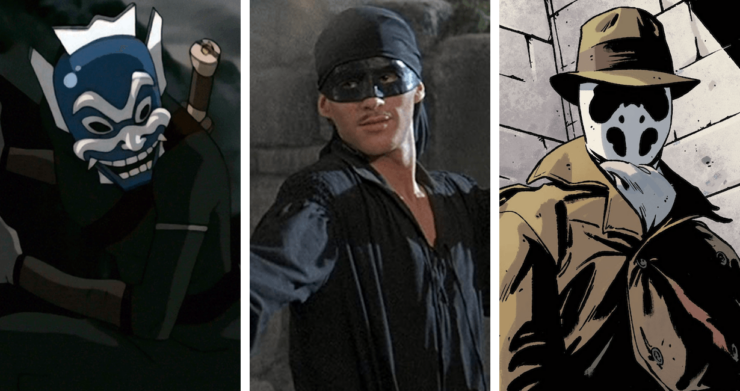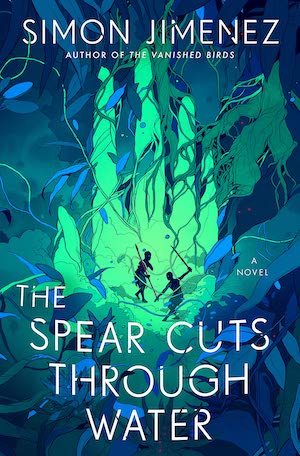Imagine for a moment the distinct narrative thrill of seeing a masked character appear for the first time. Who could it be? What are they hiding? Is it a character we already know and love, shirking their identity in favor of this mysterious persona?
In fantasy stories, masks often stand in for identity, or a character’s understanding of who they are. Donning a mask obscures a face and creates someone entirely new. Storytellers in fantasy capitalize on this duality, treating us to wonderful, compelling character development both behind and beyond the mask. So let’s talk about some favorite examples…
The Blue Spirit — Avatar The Last Airbender
Initially, I thought about saving this one for last, but I can’t. He’s gotta be first because this mask so beautifully redefines a character any viewer will come to love. Enough burying the lede: let’s talk about the Blue Spirit.
We first meet the Blue Spirit when Aang is captured in a Fire Nation fortress. Our first scenes with the mysterious warrior show us a deft agent characterized by stealth and cunningly quick thinking. The Blue Spirit rescues Aang and helps him to escape. The end of the episode reveals the true identity of the Blue Spirit —it’s our favorite tortured, honor-seeking exiled prince, Zuko! As soon as an ailing Zuko isn’t wearing the mask anymore, he immediately attacks Aang. He rescued him from Admiral Zhao’s clutches only in order to capture Aang himself. Even so, Zuko’s pent-up anger and frustration—still misdirected at Aang—releases in a bout of fury once the mask is removed, driving the young Avatar away.
Later in the series, Zuko wears the mask once again and frees Appa from Long Feng and the treacherous Dai Li. Uncle Iroh tails him and confronts Zuko, who struggles with the self-reckoning he has long avoided. The Blue Spirit represents his inner desire to do something good in spite of his belief that he must follow the destiny set forth by his father, the ruthless Fire Lord. By the end of the episode, Zuko leaves the mask behind, showing viewers that he has embraced his inner goodness and is on his way to self-actualization. The Blue Spirit lives on in Zuko; he just doesn’t need the mask to embody what it represents.
The Dread Pirate Roberts — The Princess Bride
Let’s turn now to the realm of classic fantasy: William Goldman’s The Princess Bride. I’ll stick mainly to the 1987 film adaptation though, as I’m more familiar with it.
All we know of Westley at first is his history as a farmhand and his mild-mannered ways. “As you wish,” he responds to all of Buttercup’s requests—as readers/viewers know (and Buttercup soon realizes), it’s a thinly veiled admission of love. Westley sets sail to find fortune so that he and Buttercup can marry, but after some time she receives word his ship has been attacked by the Dread Pirate Roberts. He’s presumed dead.
When Westley resurfaces, he wears a black mask over half of his face (which, in my humble opinion, does laughably little to obscure his features, but that’s beside the point). Westley’s relentless quest to reunite with Buttercup and his training with the Dread Pirate Roberts while wearing his mask allows him to embody a different persona. The mask not only hides Westley’s identity as he seeks to reclaim Buttercup from her captors, but it allows him to express his doubts, briefly giving into his fears that he’s been forgotten, or even spurned and betrayed by the woman he loves.
It’s not his finest moment, but it doesn’t last very long—still in the dark about his real identity and angry over his accusations of infidelity, Buttercup promptly shoves The Man in Black down a hill. He tumbles and rolls and his mask flies off. “As…you…wish…” he calls up to her. In that moment, this altered version of Westley reverts to his true romantic self and Buttercup realizes her mistake. The mask comes off, and Westley returns to form and his belief in true love—though he retains the swashbuckling skills and cunning he honed with the famed pirate.
Jun — The Spear Cuts Through Water by Simon Jimenez
Before we dive into this next masked warrior, a brief spoiler warning: Minor spoilers follow for The Spear Cuts Through Water. It’s one of the best fantasy books in recent years, and I recommend going in cold, so skip the next three paragraphs if you want to stay spoiler-free.
For those who have read The Spear Cuts Through Water, you’re no doubt familiar with Jun, the troubled warrior tasked with guarding the moon. Jun is the son of Saam Ossa (himself the son of the Emperor), known as the First Terror and leader of the Red Peacock Brigade. Members of the Brigade have large red tattoos on their faces to represent their allegiance. They’re feared in all corners of the world for their ruthlessness and cruelty.
Jun, however, isn’t content to live in the dark shadow cast by his father. He plots to release the moon goddess and kill the Emperor. Jun escapes with the moon goddess and dons a mask to hide his identity. Later, he unites with Keema, a one-armed warrior tasked with delivering a spear to a woman named Shan. They travel together, and all the way they’re pursued by the First Terror (and many other enemies).
The Spear Cuts Through Water is complex and layered, but Jun’s mask serves a simple purpose. The mask obscures his identity and allows him to travel somewhat freely through the land without the burden of his lineage slowing him down. His growth throughout the novel involves freeing himself from the burden of his father’s expectations and embracing his own identity, with or without the mask.
You are now free from spoilers!
Rorschach — Watchmen by Alan Moore

Our penultimate example comes from Alan Moore’s seminal graphic novel Watchmen. Plenty of masks grace the pages of the masterpiece, but Rorschach is the only one that makes our list.
Rorschach takes the mask-as-identity trope one dangerous step too far. The mask is his true face, he claims. Rorschach seeps into his id and becomes his entire personality, and the hardened man beneath it is an impostor. When Rorschach ends up in prison, the unmasked man is virtually indiscernible from the vigilante persona we know. The mask becomes the man, or vice versa, and the implications are positively terrifying.
Amon — The Legend of Korra
We started with Avatar…so why not end with it? The Legend of Korra brings us our final masked warrior: Amon. The season 1 villain, claiming to be a victim of benders’ violence, had the ability to remove people’s bending and became the head of a movement to bring “equality” to Republic City.
For first-time viewers of the show’s initial season, the final reveal shows us why Amon needed the mask: He’s using the very abilities he claims to abhor and fight against in order to serve his nefarious purposes. He hides his origins and considerable power as a bender behind his stoic mask, adopting a new, false identity and creating a powerful symbol for the frustrated non-benders of Republic City to idolize. Of course, Amon is not what he seems, and his actions and need for the mask grow more sinister as the season careens toward its explosive conclusion.
***
Based on the examples above and hundreds of others I haven’t mentioned, it’s clear that masks play a unique and irreplaceable role in fantasy. They’re often far more than simple disguises. They symbolize redefined identity and transformation (sometimes for better, and sometimes for worse). In many narratives, they help to propel characters along a path of growth and discovery without initially sacrificing what makes us love them in the first place. I’m sure you have your own memorable examples to share, so let’s discuss in the comments below!
Cole Rush writes words. A lot of them. For the most part, you can find those words at The Quill To Live or on Twitter @ColeRush1. He voraciously reads epic fantasy and science-fiction, seeking out stories of gargantuan proportions and devouring them with a bookwormish fervor. His favorite books are: The Divine Cities Series by Robert Jackson Bennett, The Long Way To A Small, Angry Planet by Becky Chambers, and The House in the Cerulean Sea by TJ Klune.











